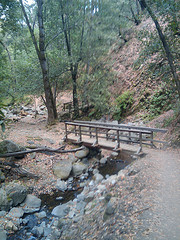By guest author Marc Johnson.
Below Marc shares some of his expertise in managing property and thinking risk management.
It’s a beautiful day and this is the first time in months you’ve had a chance to get in some hiking. You are enjoying your walk and the last thing you are thinking about is the old foot bridge you’ve just crossed over. Back up and let’s take a look. Ask yourself some questions:
- Do you know how old the bridge is? Most wood bridges if made of pressure treated wood have a life expectancy of about 25 years.
- Is the bridge made out of old utility poles? A lot of foot bridges use old utility poles. There is a reason utility companies give these away. The poles usually do not meet there engineering needs. Is this what you are counting on to support your campers and guests?
- Are there sags, splits in the wood, cracks or other visible problems? The hardware holding things together can rust out and is not always visible. Does the bridge feel “bouncy”?
- Is there a good solid foundation? Are the poles or beams just stuck in the ground on each end? Take a look under the bridge for any visible problems.
Do these questions make you wonder? At this point you may be getting a little nervous which is a good thing. If you have questions, bring in your favorite licensed contractor. We all want our campers and guests to have a safe experience. (I took out the sentence about the director, as I think it makes it confusing. To me, it flows with the rest of the article.)
After the investigation of the bridge condition you have some options:
- Everything looks ok and I am not going to do anything except regularly monitor the bridge and add it to my maintenance schedule.
- Possible renovations are needed and I will do these immediately to reinforce the bridge.
- The bridge is dangerous. It needs to be removed before someone gets hurt. Remember to close the area around the bridge and tell everyone if you are going to stop using it.
If you are going to replace the bridge, here are some things to consider:
- What laws in your state or county does this bridge fall under? If you are crossing a creek or other water source what permits do you need?
- Most bridge replacements are going to cost over $1,000.00. Does this project need to be permitted with the local building department?
- Are there any grant opportunities to investigate?
- At what point do you need to have a licensed engineer take a look at your plans?
- Who is going to tear out the old bridge or work on the replacement? What regulations or good safety practices do you need to follow?
- Can you use youth or adult volunteers in an appropriate role?
- Remember that when completed you will have time and material costs in this project. List the bridge with your insurance company.
These are just suggestions on how to proceed when determining your bridge needs. Taking these steps and communicating with everyone involved helps everyone.
Marc has worked at camp since 1970 in a variety of positions from camp director to dining hall manager. His degree work from N.C. State includes; a background in Forestry, Wildlife management and Recreation Administration. Marc has worked for the Girl Scouts at 2 councils since 1980 in property management as a camp director, camp ranger, camp manager and property director. He is also a lead visitor with the ACA.

